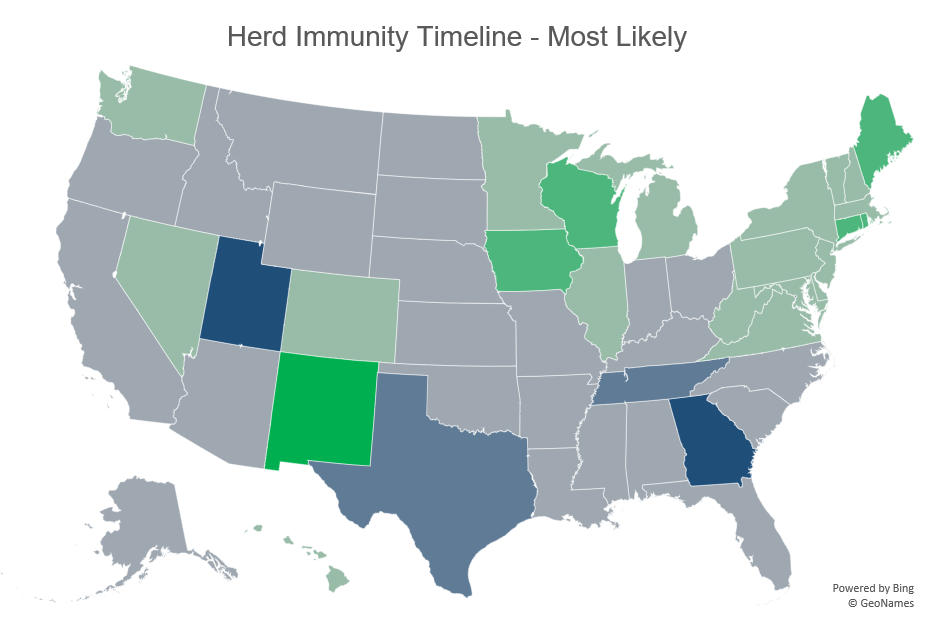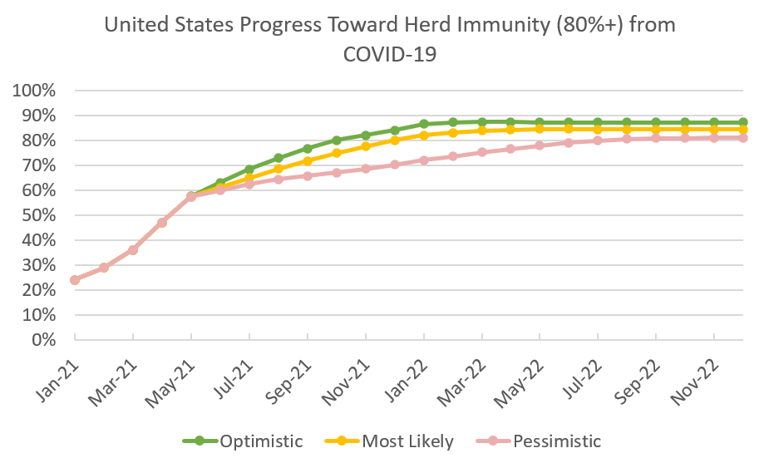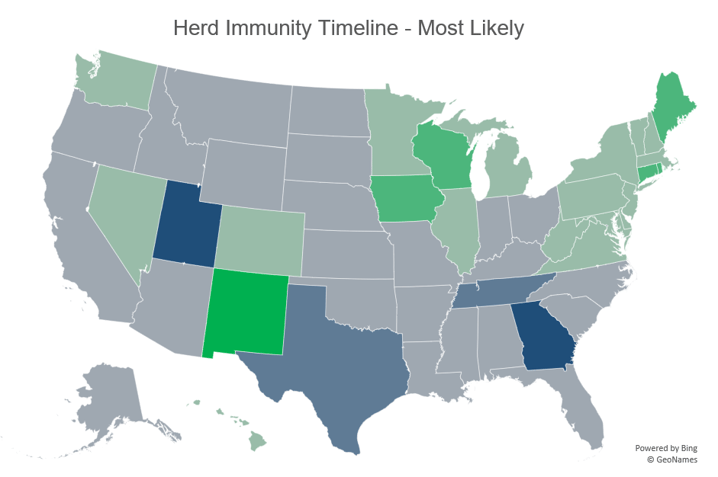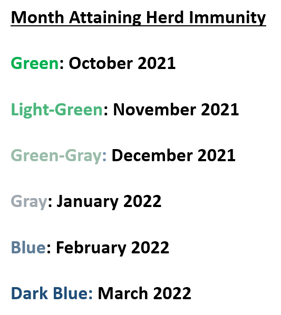Update: When Will We Reach Herd Immunity from COVID-19?

By Alex Doherty |
Model updated May 17, 2021.
Rising vaccination rates, falling case rates, and relaxing mask requirements are giving medical experts cautious optimism about a return to normalcy. While there is abundant caution about assigning a population percentage to achieve herd immunity, many experts agree about 80% of the population will need to be immune to the virus to reach herd immunity, either through vaccination or by previously contracting the virus. So when will we get there?
As of May 14, 2021, over 154 million Americans have received their first dose of the Pfizer, Moderna, or Johnson & Johnson vaccine, including about 119 million who are fully vaccinated.[1] On average for the past week, approximately 2.1 million doses have been administered per day. Using vaccination rates from the Centers for Disease Control and Prevention (CDC), estimated infection counts from the University of Washington, vaccine allotment announcements, vaccine hesitancy data from the U.S. Census’s Household Pulse Survey, vaccine eligibility by age forecasts,[2] and additional information regarding vaccination rates obtained from medical experts, Chmura built a herd immunity timeline model with three scenarios.

In the optimistic scenario, the vaccination rate in the United States exceeds President Biden’s July 4th goal of 70% of American adults receiving one dose. In this scenario, vaccination rates remain steady through May and slightly decline over the coming months. Vaccine hesitancy continues to decline. Over 80% of the U.S. population is fully vaccinated in mid-November 2021. However, after accounting for individuals immune to COVID-19 via infection, herd immunity is reached one month earlier, in the last week of October 2021.
In the most likely scenario, slightly more than 70% of American adults receive one dose of the COVID-19 vaccine by July 4th. Vaccine hesitancy declines at a slower rate and vaccination rates continue a steady, moderate decline. In this scenario, the nation fully vaccinates over 80% of its population by January 2022, and herd immunity is reached one month earlier, in December 2021.
In the pessimistic scenario, slightly less than 70% of American adults receive one dose of the COVID-19 vaccine by July 4th. In this scenario, the nation does not fully vaccinate over 80% of Americans until August 2022, and herd immunity is reached in the same month.
The following chart shows the national ramp-up toward herd immunity from COVID-19.

Note that this model includes estimated infections of COVID-19. The vast majority of individuals who contract COVID-19 are estimated to be immune from a second infection for the six months following their first infection.
States are forecast to reach herd immunity at different times, given their current vaccination rates, historical and forecast infection rates, and varying vaccine hesitancies. New Mexico is the first state forecast to reach herd immunity, projected to surpass the 80% threshold in October 2021. Several states follow suit in November, and most of the Northeast and half of the Midwest is expected to reach herd immunity by the end of 2021. The following map shows the forecast month for herd immunity by state in the most likely forecast.


Additional Assumptions of the Model
Status quo:
- 600 million total vaccine doses purchased from Moderna & Pfizer alone, including January 27, 2021 announcement of 200 million additional doses purchased. An additional 200 million doses were purchased from Johnson & Johnson (single dose vaccine)
- Over 154 million Americans have received their first dose, including over 119 million who are fully vaccinated, per the CDC as of May 14, 2021.
- The United States is currently administering about 2.1 million total doses per day
Broad Assumptions:
- States’ current vaccine administration figures are predictors of their ability to continue administering the vaccine in the future at a rate that eventually returns to the national average by the end of 2022. These rates are capped by each state’s vaccine hesitancy forecast.
- Future introduction of additional vaccines (e.g. AstraZeneca, Novavax) do not significantly alter the United States’ vaccine roll-out.
- 80% is the threshold for herd immunity, either via vaccine or antibodies via infection (assumed to remain in infected individuals for at least six months.
- Pfizer, Moderna, and Johnson & Johnson vaccines maintain high levels of efficacy against new strains of the virus.
- Children ages 12 to 15 are expected to begin receiving vaccinations within the next month.
- Children ages 6 to 11 are expected to begin receiving vaccinations by early 2022.
[1] Fully vaccinated individuals have either received two doses of the Pfizer or Moderna vaccines or have received a single dose of the Johnson & Johnson vaccine.
[2] Individuals age 16 and up are currently eligible for the Pfizer vaccine. All adults (18+) are eligible for the Moderna and Johnson and Johnson vaccines. On May 12, a CDC panel recommended the Pfizer vaccine for use in children aged 12 to 15.
Subscribe to the Weekly Economic Update
Subscribe to the Weekly Economic Update and get news delivered straight to your inbox.







